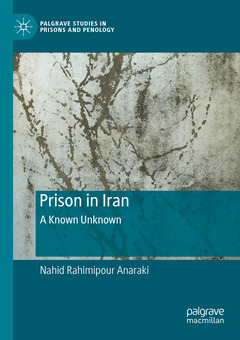Description
Prison in Iran, 1st ed. 2021
A Known Unknown
Palgrave Studies in Prisons and Penology Series
Author: Anaraki Nahid Rahimipour
Language: English
Subjects for Prison in Iran:
Approximative price 126.59 €
In Print (Delivery period: 15 days).
Add to cart
Prison in Iran
Publication date: 11-2021
178 p. · 14.8x21 cm · Paperback
Publication date: 11-2021
178 p. · 14.8x21 cm · Paperback
Approximative price 126.59 €
In Print (Delivery period: 15 days).
Add to cart
Prison in Iran
Publication date: 11-2020
178 p. · 14.8x21 cm · Hardback
Publication date: 11-2020
178 p. · 14.8x21 cm · Hardback
Description
/li>Contents
/li>Biography
/li>Comment
/li>
This book offers a unique look into prisons in Iran and the lives of the prisoners and their families. It provides an overview of the history of Iranian prisons, depicts the sub-culture in contemporary Iranian prisons, and highlights the forms that gender discrimination takes behind the prison walls. The book draws on the voices of 90 men and women who have been imprisoned in Iran, interviewed in 2012 and 2017 across various parts of the Islamic Republic of Iran. It presents a different approach to the one proposed by Michel Foucault in Discipline and Punish because the author argues that Iran never experienced ?the age of sobriety in punishment? and ?a slackening of the hold on the body?. Whilst penal severity in Iran has reduced, its scope has now extended beyond prisoners to their families, regardless of their age and gender. In Iran, penalties still target the body but now also affect the bodies of the entire prisoner?s family. It is not just prisoners who suffer from the lack of food, clothes, spaces for sleeping, health services, legal services, safety, and threats of physical violence and abuse but also their families. The book highlights the costs of mothers? incarceration for their children. It argues that as long as punishment remains the dominant discourse of the penal system, the minds and bodies of anyone related to incarcerated offenders will remain under tremendous strain. This unique book explores the nature of these systems in a deeply under-covered nation to expand understandings of prisons in the non-Western world.
Chapter 1 5
Introduction 6
The so called “prison” 6
Chapter 2 24
History of Prison 24The First Spark of Juridical Reform in Iran 24
Prisons In The Qajar Reign 27
The Constitutional Revolution 29
A Root-and-Branch Revamping of the Whole Judicial System 33
Interregnum (1941-1953) 38
Prison Life from 1971 to 1977 42
The 1979 Revolution and its impact on prison conditions 49
Chapter 3 61
Prison Subculture 61
Unstable pyramid 63
Captives as a society 88
Battle zone 91
Hegemony of drug-related networks 96
Multidimensional identity 103
Instrumental relationships 111
Two sides of the same coin 121
Chapter 4 131
Incarcerated women and children 131
Women’s Pathway to Prison 131
Incarcerated Mothers 136
The Most Visible Victims 141
Being Prisoned Outside of Prison 150
Chapter 5 165
Conclusion 165
Never accomplished modernization
Index
Nahid Rahimipour Anaraki is Postdoctoral Fellow at Memorial University of Newfoundland, Canada. She holds an MA in Sociology from the University of Kerman, Iran and a PhD in sociology from Memorial University, and she has co-authored several articles published in Quality & Quantity journal.
Makes a compelling and useful addition to the studies of prisons in the non-western world
Offers insights into histories of prison in Iran, governance and pathways
Draws on unique empirical data to understand prisoner experiences
Explores the differences between men and women's experiences
© 2024 LAVOISIER S.A.S.
These books may interest you

Surviving Russian Prisons 78.36 €



